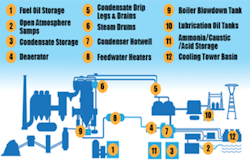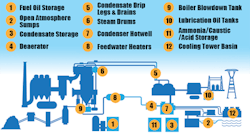12 Level Control Applications for Improved Power Plant Efficiency
The global power generation industry is rapidly changing. Increases in power consumption, economic growth, and environmental pressures are creating significant opportunities for safe and reliable plant operation.
Power Plant Efficiency Opportunities
Level control applications in power plants lend themselves to performance improvements that can enhance a plant’s overall safety, efficiency or profitability. Technologies offering more precise level indication that are not affected by process variables provide operators with the ability to better manage overall power plant performance. For example, feedwater heaters in coal-fired plants historically suffer from inefficiencies due to poor level controls, which increase heat rate, thus reducing efficiency. The illustration below indicates some of the most common level control applications in the power generation industry.
READ ALSO: Guided Wave Radar Versus Load Cells For Cell Culture Process Measurement
- Fuel Oil Storage: Crude oils with lower flash points represent a greater fire hazard and require safety-certified liquid level switches and transmitters.
- Open Atmosphere Sumps: Level control in collection and processing basins must often tolerate corrosive media, punishing weather conditions and liquids with high solids content.
- Condensate Storage: Accurate, reliable liquid level monitoring in the condensate storage tank ensures the proper supply of make-up water.
- Deaerator: Pressure fluctuations are extensive in the deaerator and result in flashing, thereby requiring level controls that can withstand varying temperatures and pressures.
- Condensate Drip Legs & Drains: Level instrumentation must contend with high temperatures and pressures associated with drip legs, to ensure proper functioning of the condensate collection system and prevent damage to the turbine.
- Steam Drums: Precise level in the steam drum is important to optimize steam/water separation and steam quality.
- Condenser Hotwell: Level control in the hotwell can prevent make-up water loss in the turbine cycle due to leakage, steam venting, or other usage.
- Feedwater Heaters: Feedwater heater level is controlled to prevent damage to expensive hardware, while at the same time optimizing level control to improve efficiency (heat rate) during base load, as well as load following operations.
- Boiler Blowdown Tank: Good boiler blowdown practices reduce water treatment needs and operation costs, as well as the chance of catastrophic explosion.
- Lubrication Oil Tanks: Reliable level monitoring of lube oil reservoirs ensures proper functioning of turbines, electrical generators and other equipment with integral lubrication systems.
- Ammonia/Caustic/Acid Storage: Managing hazardous and non-hazardous chemical storage inventory and replenishment safely and reliably is critical to ensure availability during normal operation.
- Cooling Tower Basin: Proper level control in the cooling tower basin eliminates low-level damage to pumps, while preventing costly overflow conditions. Vulnerability to foam from chemical injection and modest buildup considerations are fundamental to selecting the correct level technology.
This blog is based on a post that originally appeared on Magnetrol’s Level & Flow Solutions Blog. To learn more about Magnetrol’s level control solutions for power plant applications, read the full post here.

